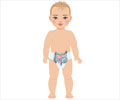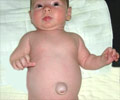A new American study has said that cold sensing in the newborn develops well after birth.

The study, led by David McKemy of the University of Southern California, appears online in Neuroscience.
McKemy, an assistant professor of neurobiology, said: "About three or four days before the animal is born, the protein is expressed. However, the axons of these nerves going into the spinal cord are not fully formed until probably two weeks after birth."
The delay in development of cold sensing is plausible, added McKemy.
He said: "In the womb, when would we ever feel cold?"
By contrast, mice are born with a keen sense of smell, which they need to breast feed successfully.
In a 2008 study of temperature sensation by the Institute of Child Health at University College London, researchers found that 11-year-old children born prematurely were less sensitive to temperature than those born at term.
"There are other reports that injury and inflammation in rodent models that occur during the [prenatal] period lead to altered temperature sensitivity as well as altered neural circuits."
The USC researchers tracked development of cold sensing through mice genetically engineered to express a green fluorescent protein whenever TRPM8 was produced.
TRPM8 is one in a class of proteins known as ion channels. Their purpose is to "turn on the cell" when they receive a stimulus. TRPM8 senses both painful cold and the soothing cold of menthol-based creams.
How one protein can convey both sensations is unknown. McKemy speculated that neurons differ in their internal architecture, with each tuned to accept either painful or pleasant cold signals from TRPM8.
One goal of TRPM8 research is to understand the molecular mechanisms of sensation, in the hope of developing better drugs for relief of chronic pain states, such as the extreme sensitivity to cold experienced by some diabetes patients.
McKemy said: "If you want to understand conditions like cold allodynia, which is cold pain, you need to find exactly what are the targets.
"If we understand the basic nuts and bolts of the molecules and neurons and how they detect pain normally then perhaps we can figure out why we detect pain when we shouldn't."
Source-ANI
 MEDINDIA
MEDINDIA



 Email
Email






